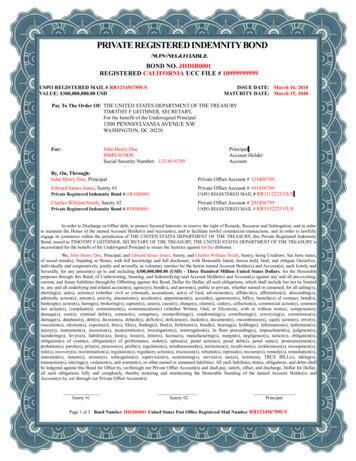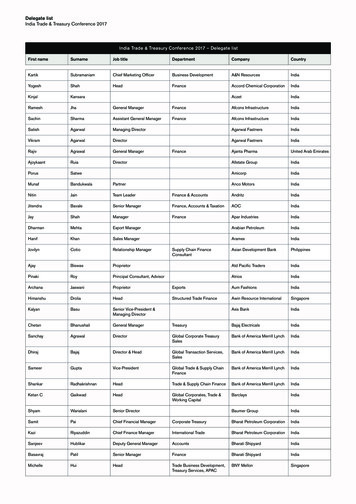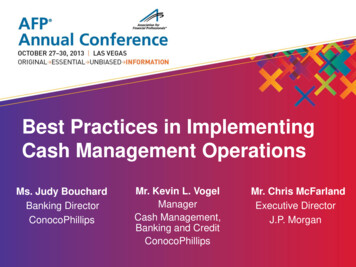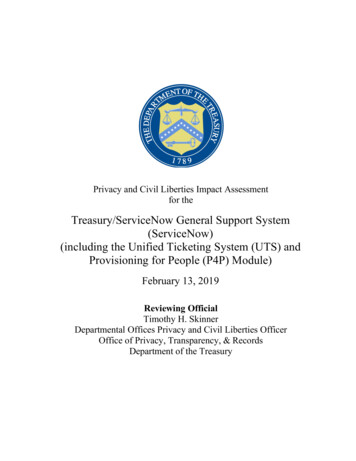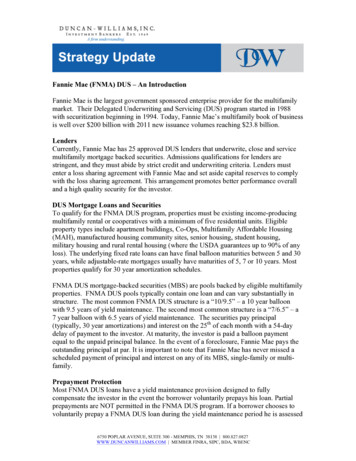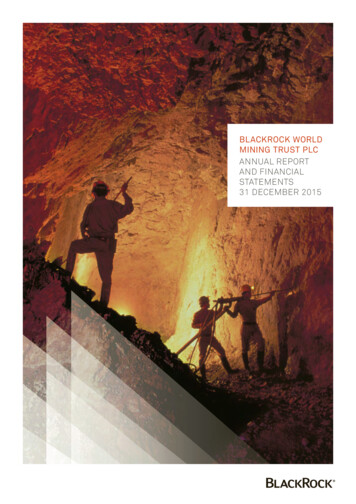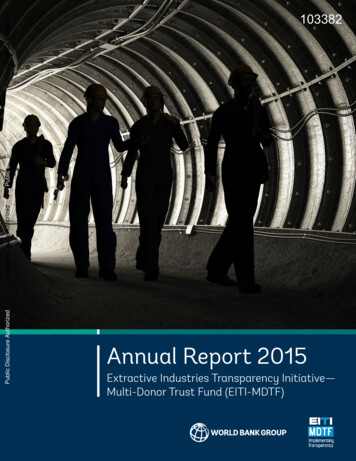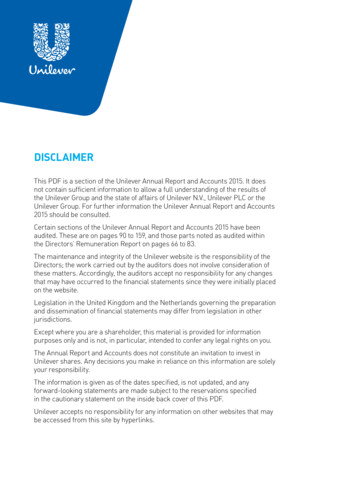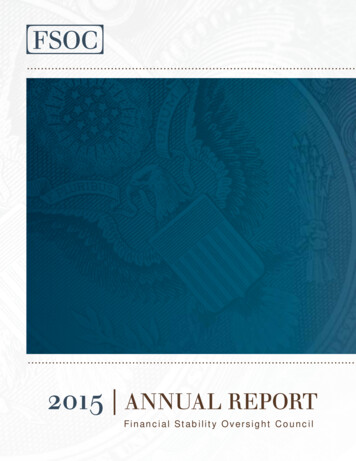
Transcription
2015 ANNUAL REPORTFinancial Stability Oversight Council
Financial Stability Oversight CouncilThe Financial Stability Oversight Council (Council) was established by the Dodd-Frank WallStreet Reform and Consumer Protection Act (Dodd-Frank Act) and is charged with threeprimary purposes:1.To identify risks to the financial stability of the United States that could arise from thematerial financial distress or failure, or ongoing activities, of large, interconnected bankholding companies or nonbank financial companies, or that could arise outside thefinancial services marketplace.2.To promote market discipline, by eliminating expectations on the part of shareholders,creditors, and counterparties of such companies that the U.S. government will shieldthem from losses in the event of failure.3.To respond to emerging threats to the stability of the U.S. financial system.Pursuant to the Dodd-Frank Act, the Council consists of ten voting members and fivenonvoting members and brings together the expertise of federal financial regulators, stateregulators, and an insurance expert appointed by the President.The voting members are: the Secretary of the Treasury, who serves as the Chairperson of the Council;the Chairman of the Board of Governors of the Federal Reserve System;the Comptroller of the Currency;the Director of the Bureau of Consumer Financial Protection;the Chairman of the Securities and Exchange Commission;the Chairperson of the Federal Deposit Insurance Corporation;the Chairperson of the Commodity Futures Trading Commission;the Director of the Federal Housing Finance Agency;the Chairman of the National Credit Union Administration; andan independent member with insurance expertise who is appointed by the Presidentand confirmed by the Senate for a six-year term.The nonvoting members, who serve in an advisory capacity, are: the Director of the Office of Financial Research;the Director of the Federal Insurance Office;a state insurance commissioner designated by the state insurance commissioners;a state banking supervisor designated by the state banking supervisors; anda state securities commissioner (or officer performing like functions) designated by thestate securities commissioners.The state insurance commissioner, state banking supervisor, and state securities commissionerserve two-year terms.F i n a n c i a l S t a b i l i t y O ve r s i g htiC o u n c i li
Statutory Requirements for the Annual ReportSection 112(a)(2)(N) of the Dodd-Frank Act requires that the annual reportaddress the following:i. the activities of the Council;ii. significant financial market and regulatory developments, includinginsurance and accounting regulations and standards, along with anassessment of those developments on the stability of thefinancial system;iii. potential emerging threats to the financial stability of the UnitedStates;iv. all determinations made under Section 113 or Title VIII, and thebasis for such determinations;v. all recommendations made under Section 119 and the result of suchrecommendations; andvi. recommendations—I. to enhance the integrity, efficiency, competitiveness, andstability of United States financial markets;II. to promote market discipline; andIII. to maintain investor confidence.Approval of the Annual ReportThis annual report was approved unanimously by the voting members of theCouncil on May 19, 2015. Except as otherwise indicated, data cited in this reportis as of March 31, 2015.Abbreviations for Council Member Agencies and Member Agency Offices iiDepartment of the Treasury (Treasury)Board of Governors of the Federal Reserve System (Federal Reserve)Office of the Comptroller of the Currency (OCC)Bureau of Consumer Financial Protection (CFPB)Securities and Exchange Commission (SEC)Federal Deposit Insurance Corporation (FDIC)Commodity Futures Trading Commission (CFTC)Federal Housing Finance Agency (FHFA)National Credit Union Administration (NCUA)Office of Financial Research (OFR)Federal Insurance Office (FIO)2 0 1 5 F S O C / / Annual Report
Contents1 Member Statement . 12 Executive Summary . 33 Annual Report Recommendations . 93.1 Heightened Risk Management and Supervisory Attention .93.2 Reforms to Address Structural Vulnerabilities .154 Macroeconomic Environment . 194.1 U.S. Economic Activity .194.2 Nonfinancial Balance Sheets.224.3 Government Finance .26BOX A: Municipal Debt Markets: Challenges in Puerto Rico .294.4 External Environment.30BOX B:ECB’s Comprehensive Assessment of Euro Area Banks .325 Financial Developments. 375.1 Asset Valuations .37BOX C:Implications of Lower Oil Prices .445.2 Wholesale Funding Markets .535.3 Bank Holding Companies and Depository Institutions .575.4 Nonbank Financial Companies .675.5 Investment Funds .765.6 OTC Derivatives Markets.81BOX D:Overview of Central Counterparties Relevant to OTCDerivatives Markets.84C o n te n t siii
6 Regulatory Developments & Council Activities. 876.1 Safety and Soundness .876.2 Financial Infrastructure, Markets, and Oversight.936.3 Mortgage Transactions, Housing, and Consumer Protection .976.4 Data Gaps and Standards .986.5 Council Activities .1017 Potential Emerging Threats and Vulnerabilities . 1057.1 Cybersecurity: Vulnerabilities to Attacks on Financial Services.1057.2 Increased Risk-Taking in a Low-Yield Environment .1067.3 Changes in Financial Market Structure and Implications for FinancialStability .107BOX E:Financial Markets on October 15, 2014 . 1097.4 Central Counterparties . 1117.5 Global Economic and Financial Developments . 1127.6 Financial Innovation and Migration of Activities . 1137.7 Short-Term Wholesale Funding . 1157.8 Risk-Taking Incentives of Large, Complex, Interconnected FinancialInstitutions . 1157.9 Reliance upon Reference Rates . 1187.10 Challenges to Data Quality, Collection, and Sharing .120Abbreviations .121Glossary . 129List of Charts . 139iv2 0 1 5 F S O C / / Annual Report
1Member StatementThe Honorable John A. BoehnerSpeaker of the HouseUnited States House of RepresentativesThe Honorable Joseph R. Biden, Jr.President of the SenateUnited States SenateThe Honorable Nancy PelosiDemocratic LeaderUnited States House of RepresentativesThe Honorable Mitch McConnellMajority LeaderUnited States SenateThe Honorable Harry ReidDemocratic LeaderUnited States SenateIn accordance with Section 112(b)(2) of the Dodd-Frank Wall Street Reform and Consumer ProtectionAct, for the reasons outlined in the annual report, I believe that additional actions, as described below,should be taken to ensure financial stability and to mitigate systemic risk that would negatively affectthe economy: the issues and recommendations set forth in the Council’s annual report should be fullyaddressed; the Council should continue to build its systems and processes for monitoring and respondingto emerging threats to the stability of the United States financial system, including those described in theCouncil’s annual report; the Council and its member agencies should continue to implement the laws theyadminister, including those established by, and amended by, the Dodd-Frank Act, through efficient andeffective measures; and the Council and its member agencies should exercise their respective authoritiesfor oversight of financial firms and markets so that the private sector employs sound financial riskmanagement practices to mitigate potential risks to the financial stability of the United States.Jacob J. LewSecretary of the TreasuryChairperson, Financial Stability Oversight CouncilJanet L. YellenChairBoard of Governors of the Federal Reserve SystemThomas J. CurryComptroller of the CurrencyOffice of the Comptroller of the CurrencyRichard CordrayDirectorBureau of Consumer Financial ProtectionMary Jo WhiteChairSecurities and Exchange CommissionMartin J. GruenbergChairmanFederal Deposit Insurance CorporationTimothy G. MassadChairmanCommodity Futures Trading CommissionMelvin L. WattDirectorFederal Housing Finance AgencyDebbie MatzChairmanNational Credit Union AdministrationS. Roy Woodall, Jr.Independent Member with Insurance ExpertiseFinancial Stability Oversight CouncilM e m b e r S t a te m e n t1
2Executive SummaryVulnerabilities in the U.S. financial system remained moderate over the past year. Domestic economicconditions improved and regulators continued to make progress in financial reforms, which furtherstrengthened the balance sheets of financial institutions. The U.S. financial system successfullyweathered a variety of shocks from abroad. These included rising geopolitical tensions in Ukraine andthe Middle East; slowing growth in Europe, Japan, and China; renewed concerns about the sustainabilityof Greece’s debt; and a sharp drop in oil prices. Despite improvements in some areas, the financialsystem became more vulnerable to shocks in other areas. For example, recent cyber attacks haveheightened concerns about the potential of an even more destructive incident that could significantlydisrupt the workings of the financial system. Also, the continued low-rate environment has encouragedsome investors to take on more risk by reaching for yield.Over the past year, progress toward financial reforms included further strengthening of capital,leverage, and liquidity standards for financial institutions; continued application of supervisory andcompany-run stress tests; ongoing supervisory review and comment on large banking organizations’resolution plans; adoption of a credit risk-retention requirement for asset-backed securities (ABS);adoption of money market mutual fund (MMF) and credit rating agency reforms; and other measuresto enhance consumer protections. In the tri-party repo market, intraday credit exposures have largelybeen eliminated. In addition, the Council made a determination that a nonbank financial company willbe subject to Federal Reserve supervision and enhanced prudential standards, and completed its firstannual reevaluations of three previous determinations. The Council also conducted extensive publicoutreach regarding potential risks posed by asset management products and activities.The Council regularly examines significant market developments and structural issues within thefinancial system. For example, over the past year, the Council has considered issues such as short-termwholesale funding, cybersecurity, volatility in fixed income markets, equity market structure, highfrequency and automated trading activities, leveraged lending, reference rate reform, and interestrate risk at a variety of financial institutions. The Council will continue to monitor potential threats tofinancial stability, whether from external shocks or structural weaknesses, and to facilitate coordinationamong federal and state agencies.This year’s annual report highlights two new topics that have received increased regulatory attention:changes in financial market structure and central counterparties (CCPs). In particular, the reportdiscusses how changes in financial market structure—including trends that predate the financialcrisis—may impact the provision of liquidity and market functioning. With regard to CCPs, which aredesigned to enhance financial stability, the report highlights the importance of taking steps so thatCCPs have robust frameworks for risk management. Below are the key potential emerging threats andvulnerabilities, as well as recommended reforms identified by the Council.E xe c u t i v e S u m m a r y3
CybersecurityOver the past year, financial sector organizations and other U.S. businesses experienced numerous cyberincidents, including large-scale data breaches that compromised financial information. Malicious cyberactivity is likely to continue, and financial sector organizations should be prepared to mitigate the threatposed by cyber attacks that have the potential to destroy critical data and systems and impair operations.Treasury and the U.S. regulators have taken steps to prompt financial institutions to mitigate risks to thefinancial system posed by malicious cyber activities. As cyber threats continue to evolve, strong collaborationand data sharing among financial service companies and government agencies; improvements in technologyinfrastructure; and adequate plans for responding to and recovering from cyber incidents will remain criticalareas of focus.Increased Risk-Taking in a Low-Yield EnvironmentThe historically low-yield environment continues to encourage greater risk-taking across the financial system.Investors may seek incremental gains in yield for disproportionate amounts of risk. Banks, credit unions, andbroker-dealers have lower net interest margins (NIMs), leading some firms to increase risk by holding longerduration assets, easing lending standards, or engaging in other forms of increased risk-taking. For example,federal banking agencies have found serious deficiencies in underwriting standards and risk managementpractices for certain leveraged loans. Although more recent data may suggest improvement in the quality ofnewly issued loans, the growth in loan issuance combined with the decline in credit risk premia in recentyears warrants further monitoring. The low-rate environment is also making it difficult for pension andretirement funds to meet their long-term liabilities, some of which are seeking to boost returns by extendingthe duration of their assets or by purchasing lower quality, higher- yielding assets. Some insurance companieshave also repositioned their investment portfolios in a similar fashion. A sharp increase in interest rates orcredit spreads could generate losses on longer-term assets, including less liquid assets such as high-yield andemerging market bonds. If such losses are borne by leveraged investors, they could lead to fire sales andfurther declines in asset prices.Changes in Financial Market Structure and Implications for Financial StabilityFinancial market structure has evolved substantially over the years, owing to a confluence of factors includingtechnology, regulation, and competition. As electronic trading has captured an increasingly significant shareof total trading, electronic trading platforms and algorithmic trading firms now play an increasing role infacilitating market liquidity. In addition, the business models and risk appetite of traditional broker-dealershave changed, with some broker-dealers reducing their securities inventories and, in some cases, exitingcertain markets. New trading venues and platforms have also developed or expanded in certain markets,including new regulated exchanges, interdealer platforms, and dark pools among others. As this evolutionof market structure plays out across a broader collection of asset classes and markets, market participantsand regulators should continue to monitor how it affects the provision of liquidity and market functioning,including operational risks.Central CounterpartiesFollowing the crisis, U.S. and foreign regulators have encouraged or required more derivatives and otherfinancial transactions to be cleared through CCPs. CCPs require robust frameworks for risk managementif they are to enhance financial stability and increase market resiliency. Regulators have taken significantsteps in recent years to promote strong risk management at systemically important CCPs and remain focusedin identifying and mitigating any potential threats to financial stability that could arise from CCPs. Inparticular, it is important to evaluate whether existing rules and standards are sufficiently robust to mitigatethe risk that CCPs could transmit credit and liquidity problems among financial institutions and marketsduring periods of market stress.42 0 1 5 F S O C / / Annual Report
Global Economic and Financial RisksIn today’s globally integrated financial markets, foreign shocks have the potential to disrupt financialstability in the United States. In 2014, concerns about stability in the euro area resurfaced amid weakeconomic growth and political uncertainty in Greece. It is unclear whether Greece will be able to implementthe reforms needed to maintain the European Union (EU)-International Monetary Fund (IMF) financialassistance program, which it needs to meet debt obligations coming due later in 2015. In China, an abruptcorrection in the property market could cause financial stress and pressure on the economy. Furthermore,the rapid growth in dollar credit to emerging market economies (EMEs) raises concerns that a disorderlyincrease in yields in advanced economies or a sudden change in market sentiment could trigger a sell-off inemerging market bonds and destabilize markets, as occurred in the summer of 2013.Financial Innovation and Migration of ActivitiesTechnology, competition, and regulatory changes are continuously reshaping the financial system andbringing about innovations in products, services, and business practices, which benefit investors andconsumers. Since the financial crisis, the changing financial system landscape has fostered many innovations.One challenge for regulators is the need to monitor new products or services in light of existing standardsand regulations. Another challenge is the migration of activities to less regulated or unregulated institutions.Short-Term Wholesale FundingDomestic banking firms’ reliance on short-term wholesale funding has decreased since the financial crisis.The decline reflects in part the large growth in retail deposits and adjustments some banks are making totheir funding and balance sheet structures in response to enhanced liquidity standards—such as the liquiditycoverage ratio (LCR)—and capital requirements—such as the supplementary leverage ratio (SLR). Similarly,total borrowing by primary dealers across all segments of the repurchase agreements (repo) market wasessentially flat in 2014.Previous annual r
The state insurance commissioner, state banking supervisor, and state securities commissioner serve two-year terms. ii 2015 FSOC // Annual Report Statutory Requirements for the Annual Report Section 112(a)(2)(N) of the Dodd-Frank A

